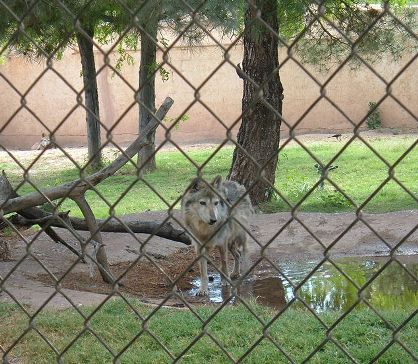23
Feb
Not Such Big, Bad Wolves: Eureka’s Endangered Wolf Center

Those who are familiar with well-known St. Louis attractions like the zoo and Botanical Gardens may be surprised to learn that St. Louis County also claims a sanctuary for some of the most fabled, feared and admired of creatures: wolves. The Endangered Wolf Center in Eureka, Mo. is a non-profit organization founded in 1971 by zoologist [Marlin] Perkins and a safe place for Mexican gray wolves, swift foxes, maned wolves and other canine species. The dedicated individuals who run the establishment ultimately work toward a long-distance goal of reintroducing native wolf species to their original environments through research and controlled breeding programs. They also aim to educate the public about the vital role wolves play in the ecosystem. Without these large predators, grazing animals like deer and elk would soon decimate the vegetation that sustains them and many other animals. The bad reputation that follows “big, bad wolves” in human society is a tough one to beat, but the Eureka center and others like it play a part in tearing down the stereotypes.
The primary species to benefit from the Endangered Wolf Center’s reintroduction programs are Mexican gray wolves (native to the southwestern United States) and red wolves (native to North Carolina.) Both varieties of wolf number fewer than 100 individuals living in the wild and conservation experts credit the center with saving the Mexican gray in particular. In 2011, the center saw the birth of four litters of pups*, at least one of which was filmed by “Lair Cam” in an attempt to gain public attention. The facility currently houses 40 animals, some of which are “adoptable” on the center’s website, www.endangeredwolfcenter.org. The website also offers learning resources such canid species information pages, image galleries, an interactive wolf pack game for kids and information about the dangers of hybrid pets.
It may seem strange that such a successful and significant establishment goes relatively unnoticed when compared to other educational attractions in the St. Louis area. However, the Endangered Wolf Center is in a special situation when it comes to receiving visitors that could bring it much-needed funds and publicity. The wolves living at the center are not zoo animals to be kept in captivity their entire lives. Since one of the primary goals is to reintroduce the wolves into the wild, the animals must be protected from too much exposure to humans. While the center currently cannot have regular hours for visitors to come and go, public tours are offered with reservations on weekends and private tours can be scheduled for any day of the week. Tours include a guided walk around the facility and visitors are welcome to bring binoculars and cameras. The center also hosts summer camps for children and evening events such as campfire wolf howl sessions throughout the year. Information on all events can be found on their website or by calling (636) 938-5900.
If you are interested in helping the Endangered Wolf Center, you can become a member, make a donation, adopt a wolf or even become a volunteer. You can also find them on Facebook.
*****
Reprinted from The McKendree Review
*The Endangered Wolf Center informed us that this article was in error about the number of litters born there last year; EWC had one litter of Mexican pups born last year out of only four born world-wide in captivity. Learn more about Captive Breeding and the facilities working to maintain a healthy gene pool here.
There needs to be more Mexican wolves released into the wild. Click here to learn what some of the “road blocks” have been.
Please contact the Secretary of the Interior and the U.S. Fish and Wildlife Service today and tell them it’s time to put more wolves into the wild where they belong.
In your message, you can include the points below, but please use your own words so that your message will be more effective:
* Mexican gray wolves need to live wild, and wild places need them.
* New releases of wolves into the wild are needed badly to bolster the population of only 50-55 wolves that remain in the wild. Newly released wolves will not only increase population numbers but will also improve the wild population’s genetics.
* There have been no releases of new Mexican wolves into the wild since November 2008. As the agency with ultimate authority and responsibility for restoring the Mexican wolf, the US Fish and Wildlife Service should be doing anything it can do to confirm its commitment to the wolf’s success in the wild.
* Talk about who you are and why Mexican wolf recovery is important to you, personally.
Please add your name and address at the end, because anonymous letters get little attention. Remember, too, that polite requests are more effective.
Send your e-mail to Director Benjamin Tuggle at RDTuggle@fws.gov and Secretary of the Interior, Ken Salazar: exsec@ios.doi.gov
Please send us a copy as well, so that we can track the actions taken to save these wonderful animals.
Thank you for all you do.
Photo courtesy of Allen S.



